You’re at a stoplight on a busy morning, driving your kids to school. The car still smells like coffee, and you glance in the rearview mirror to check on them. You know they’re buckled in, but you check anyway. Your oldest starts to say something just as a blur outside your window catches your eye.
A homeless man is standing inches from your car, almost pressed against the glass. Before you can process it, he’s reaching for the door handle and yanking on it, trying to get in.
Your heart pounds. Your mind races. Are the kids safe? Are you? Were you ready for this?
Sounds dramatic, right? But it’s not far from something that happened to me. I was living in Boston, driving to a job site with a coworker. We were stopped at a red light downtown, talking about work, when a homeless man suddenly pulled my car door open. I was lucky. He just wanted some cash or maybe to wash my windshield. It could have been much worse. I learned two things that day: always lock your doors, and always pay attention. Thankfully, no one was hurt.
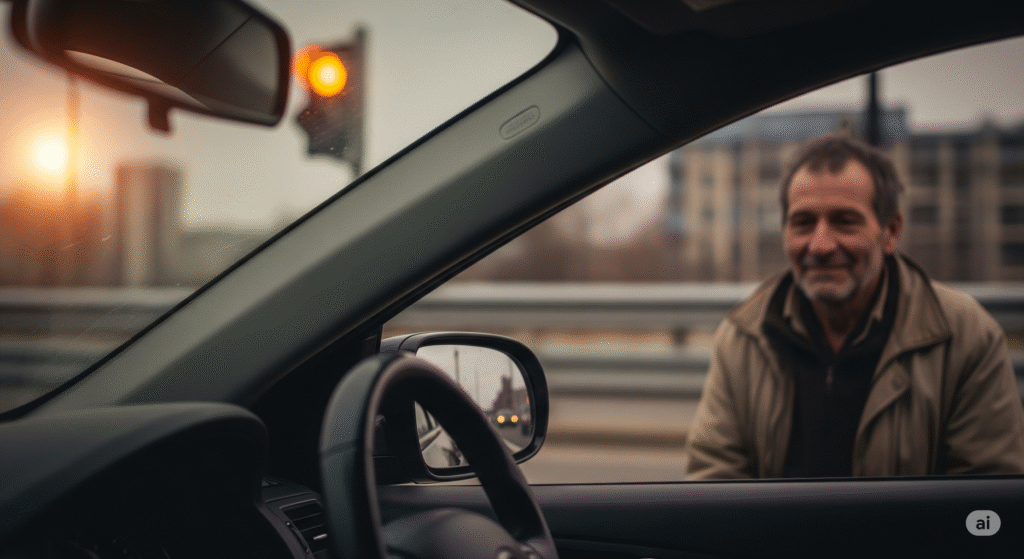
Things like that happen every day in cities across the country. A car isn’t just for getting around; it’s your family’s mobile safe space. That makes it worth preparing for more than just a flat tire.
That’s the whole idea behind a Car Everyday Carry kit, or Car EDC. It’s a practical kit you keep in your vehicle to help you handle the unexpected. It could be anything from a roadside emergency to a tense encounter. Unlike a huge bug-out bag, a Car EDC is built for your actual life, like running errands, commuting, or dropping the kids at school. It’s a simple mix of tools, emergency gear, and a little extra peace of mind.
In this article, we’ll cover two things:
- A practical guide to building your own Car EDC kit or Get-Home Bag, whether you’re planning for breakdowns, bad weather, or sketchy situations.
- Official safety advice from agencies like Ready.gov, so you know what the experts recommend packing.
By the end, you’ll have a clear plan to turn your vehicle into a prepared space for whatever life throws at you.
Car Everyday Carry: Why Every Driver Needs One
Most people see their car as just a way to get from point A to B. But if you’ve ever been stranded on the side of the road, stuck in traffic during a heatwave, or startled by someone at your window, you know your car can quickly become your last line of defense.
That’s where a Car EDC comes in. It’s not just a random pile of gear under your seat. It’s a well-chosen set of items to help you handle problems right then and there, whether it’s a mechanical issue, a medical need, or a personal safety scare.
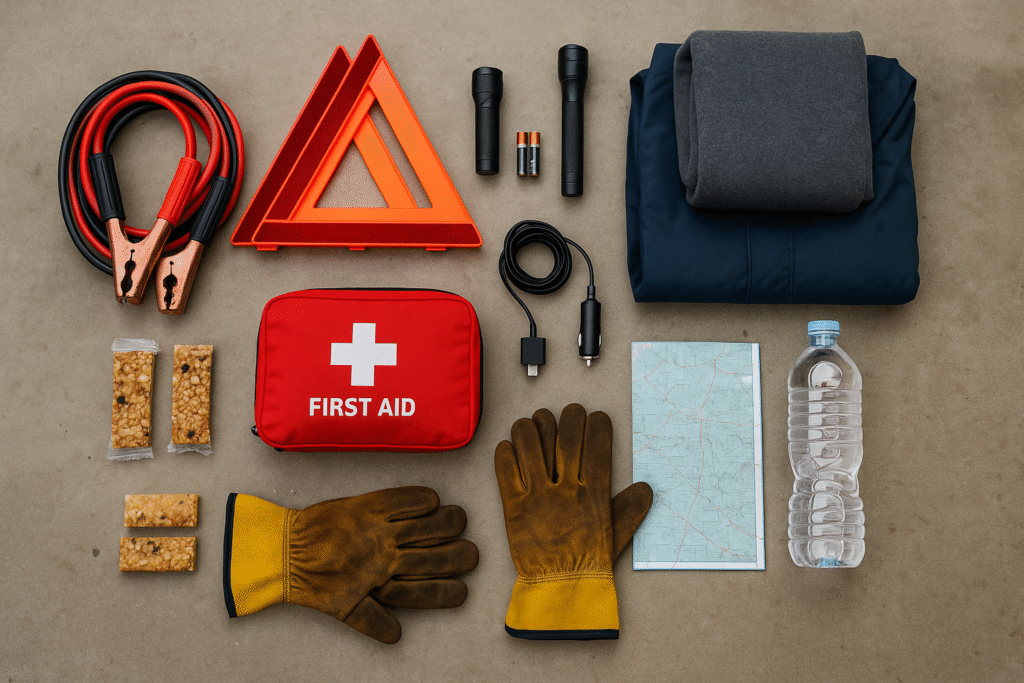
More Than a Roadside Kit
Most drivers have jumper cables and a spare tire. That’s a good start, but a Car EDC takes it a step further. It combines practical vehicle gear with personal safety tools so you’re ready for more situations. A good kit covers you from multiple angles:
- A flat tire kit gets you back on the road.
- A flashlight keeps you visible and safe at night.
- A multi-tool can handle minor fixes.
- Even a simple phone charger can be a lifesaver if you’re stranded.
A Moving Safe Space for Your Family
If you’re like most people, your car is often filled with your most precious cargo, like your kids, spouse, or friends. Your car is a mobile refuge, so why not treat it that way?
A good Car EDC isn’t about living in fear. It’s about being smart. It’s knowing that if something unexpected happens, you’ve stacked the odds in your favor.
For more urban EDC ideas, check out my guide on How to Build a Minimalist Urban EDC Kit.
Ready to see what goes into a solid Car EDC kit? Let’s get into the nuts and bolts.
Car Everyday Carry Kit: A Practical Loadout Guide
Building a Car EDC kit doesn’t mean you need to stuff your trunk with tactical gear. It’s about putting together a smart mix of everyday items and emergency tools that fit your life. Your loadout should be tailored to what matters most: keeping yourself and your loved ones safe.
The Basics That Keep You Moving
Start with the obvious things that keep your car running or help when you’re stuck.
- Jumper cables or a jump pack: Dead batteries always happen at the worst times.
- Portable tire inflator & patch kit: A slow leak doesn’t have to ruin your day.
- Small tool kit: A few screwdrivers, pliers, and some duct tape can save you from waiting hours for a tow truck.
I learned this the hard way. My wife and I were driving our Hyundai Sonata to Target one afternoon. It wasn’t far, maybe 10 or 12 minutes from the house. About five minutes in, we heard a heavy thumpa-thumpa from the back. I thought it was just a low tire, but my wife said, “It’s flat. I know that sound.”
She was right. We pulled over and swapped on the spare, only to find out it was nearly flat, too. We ended up limping home at about 5 miles an hour.
A maintenance worker from the local school district saw us creeping along and flagged us down. He had a portable tire inflator in his car that saved the day. Ever since then, we keep a can of Fix-a-Flat, a 4-prong tire iron, jumper cables, and our own portable inflator in both of our cars.
What did we learn? Never assume your emergency gear is ready when you need it. Having the right tools would’ve saved us a lot of time and, honestly, some embarrassment.
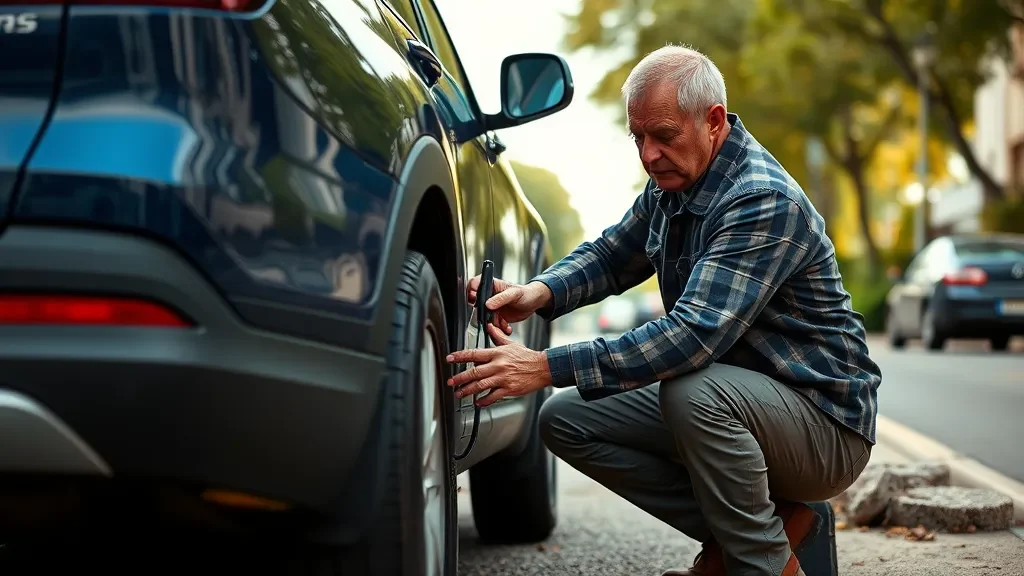
Safety & Signaling Gear
Next, think about staying safe and visible if you’re stopped on the side of the road.
- Flashlight with extra batteries: This helps with roadside checks and can also be a deterrent if someone shady approaches.
- Reflective triangles or LED road flares: These keep other drivers from clipping you.
- Bright vest: This makes you much more visible if you have to get out of your car.
If you’ve ever had to step out on a dark highway with cars flying by, you know how critical these are.
Personal Safety & Kids in Mind
Then there’s the personal stuff, especially if you have kids.
- First aid kit: Make sure it has kid-friendly items like fun bandages, antiseptic wipes, and tweezers for splinters.
- Emergency snacks & bottled water: Kids get cranky when they’re hungry. Simple protein bars or crackers can keep a stressful situation from getting worse.
- Blankets: These are great for warmth in the winter or just for comfort if you’re stuck waiting.
For personal safety, some people keep pepper spray or a tactical flashlight within reach. If someone tries to open your door again, you’ll want more options than just yelling.
A Quick Note on Organization
It’s easy for all this stuff to become a junk pile in your trunk. Use a small tote, a milk crate, or a trunk organizer to keep everything sorted. That way, you’re not digging through grocery bags and soccer balls when stress is high.
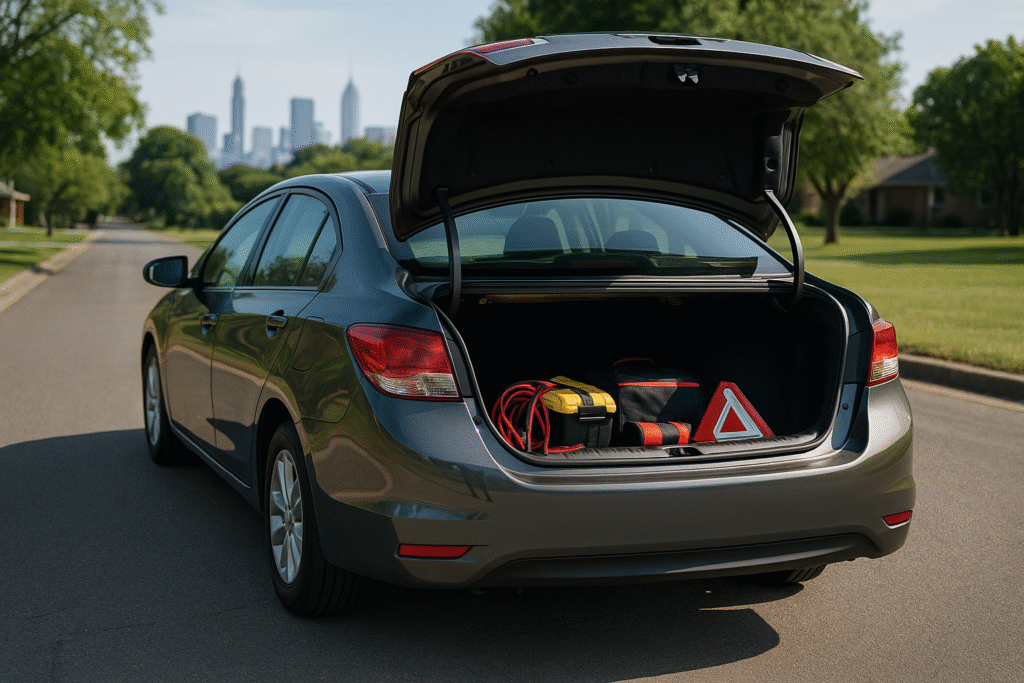
Another Note About Weather
Where you live plays a big role in what you pack. In cold climates, water bottles can freeze and crack. Here in Phoenix, we have the opposite problem. Car interiors can hit 140 degrees, so anything that can melt or spoil will go bad fast.
A simple fix is to keep a small bag of snacks and water by your door at home. If the weather is extreme, just grab it on your way out. That way, you’re not stuck with a sun-baked granola bar or a frozen water bottle when you really need them.
Car Everyday Carry: EDC Essentials List
Here’s a straightforward list you can use to build your own Car EDC kit or just to double-check what you already have.
This list isn’t the final word; it’s a solid starting point. You might skip the tire repair kit if you live in a big city and have roadside assistance. Or maybe you’ll add a small crowbar if you commute through rougher neighborhoods. Your life changes, so your kit should, too.
Tools & Repair Gear
- Jumper cables or a jump starter
- Portable tire inflator
- Tire repair kit or Fix-a-Flat
- 4-way lug wrench
- Duct tape and zip ties
- Small tool kit (screwdrivers, pliers, adjustable wrench)
Safety & Signaling
- LED road flares or reflective triangles
- Flashlight (with extra batteries)
- Safety vest
- Whistle or small air horn
First Aid & Hygiene
- Quality first aid kit
- Nitrile gloves
- Wet wipes or hand sanitizer
- Extra masks
Comfort & Survival
- Blanket or small sleeping bag
- Snacks that won’t spoil (trail mix, jerky, sealed bars)
- Bottled water (or a plan to rotate it seasonally)
- Lighter and stormproof matches
- Small power bank or car phone charger
Personal Safety Items
- Pepper spray (if legal in your area)
- Tactical pen or flashlight
- Personal alarm
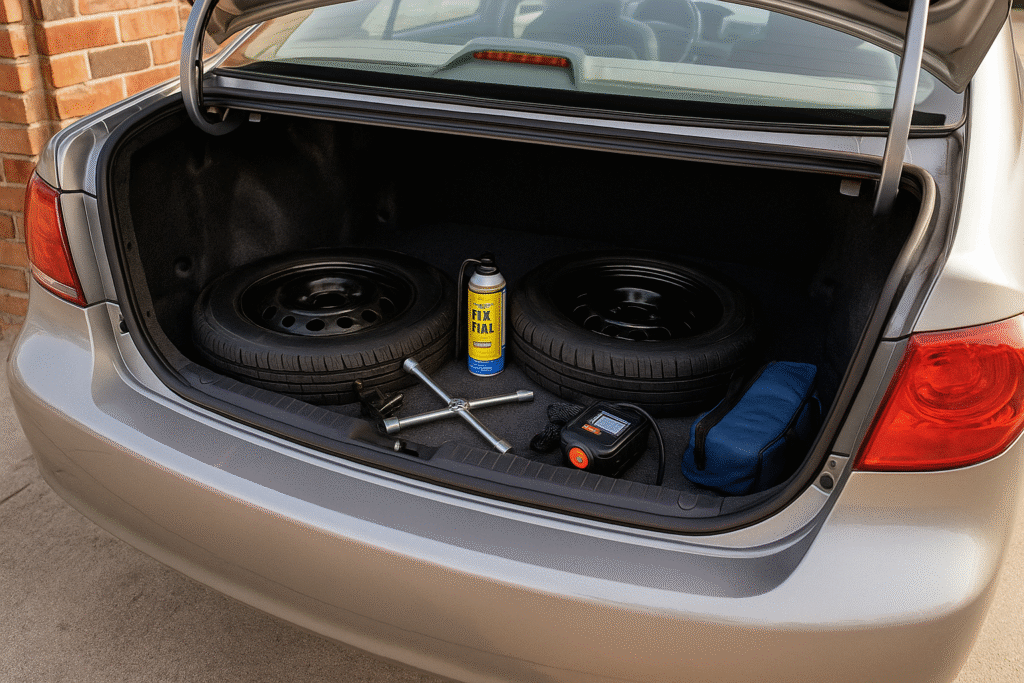
The goal isn’t to have a perfect gear list. It’s to build a setup that fits your daily life and gives you peace of mind when you turn the key.
This is just one part of a bigger system I call the READY System, a framework to help everyday people build realistic EDC habits. If you want to help shape it, I’m offering early access to the first few chapters of my upcoming book. 👉 Grab your free chapters and help shape the READY System here.
Building Your Driving EDC Handgun Setup
Your EDC should be secure, easy to access, and legal. Laws vary quite a bit. For example, California requires locked handgun storage in vehicles, but Arizona allows concealed carry with a permit. Non-lethal tools like pepper spray might also have size limits. Always check your city’s police website or state laws for vehicle regulations.
A bulky handgun or a heavy multi-tool is just a hassle in a car console, saddlebag, or bike pouch. You should pick gear that fits easily into a small bag, purse, or vehicle safe.
Consider your daily drive. Are you commuting in an SUV? Riding a motorcycle to work? Biking to the store? My kit, which I’ve tested in Phoenix and Boston, includes a small handgun, a slim knife, and a flashlight that work for any vehicle. My wife keeps a holster in her SUV console and a pepper gel in her bike bag. It’s practical for any parent. Make sure to test your gear on your own drive to stay calm and ready. If you’re looking for more specific recommendations for car carry, explore my article on The Best Handguns for Vehicle Everyday Carry (EDC)
Motorcycle EDC (The “Born To Be Wild” Bonus)
While this article is about cars and trucks, we can’t forget about riders. Motorcycles have their own challenges. Space is tight, weather is a bigger deal, and your safety margin is a lot thinner.
Full disclosure: I don’t own a motorcycle. I’ve ridden them, but this section is based on research and talking with riders.
When your EDC is strapped to a bike, every ounce counts. Riders tend to focus on the absolute must-haves:
- Compact tool roll: For tightening mirrors, adjusting the chain, or fixing loose bolts.
- Tire repair kit & CO2 cartridges: A flat on a back road is a whole different problem on two wheels.
- Emergency poncho or rain gear: Weather can turn bad in a hurry.
- Small power bank: Your phone might be your only lifeline.
- Basic first aid kit: Slimmed down to just the essentials.
- Reflective vest or clip-on lights: If you’re stopped, being seen is everything.
- JM4 Tactical Magnetic Holster This holster works well for compact handguns like the Glock 43. Its magnetic retention and leather design keep the gun secure under a jacket or in a tank bag, which is perfect for motorcycles. The quick-release clip is also great for dynamic riding positions.
- Quad Lock Motorcycle Phone Mount This mount securely holds smartphones (like iPhones or Samsungs) with a dual-stage lock that resists vibration up to 80 mph. It’s made from aluminum and polycarbonate, weighs 2.5 oz, and mounts to handlebars or mirrors for navigation.
- Sabre Red Pepper Gel This pepper gel sprays up to 18 feet and comes in a 0.69 oz canister that fits easily in a tank bag or bike pouch. The gel formula means less wind blowback. Just be sure to check your local laws, as it’s legal in many cities.
- CruzTOOLS SpeedKIT Tool Kit This is a compact motorcycle tool kit (7” x 3” x 1.5”, 1 lb) that includes metric Allen wrenches, screwdriver bits, and a tire pressure gauge for roadside fixes. It fits under seats or in saddlebags. Cruz makes toolkits for Harley Davidson and various Japanese Motorcycles..
Many riders also keep copies of their insurance and ID in a waterproof pouch and hide a spare key on the bike. In the end, motorcycle EDC is all about staying light while covering your biggest risks.
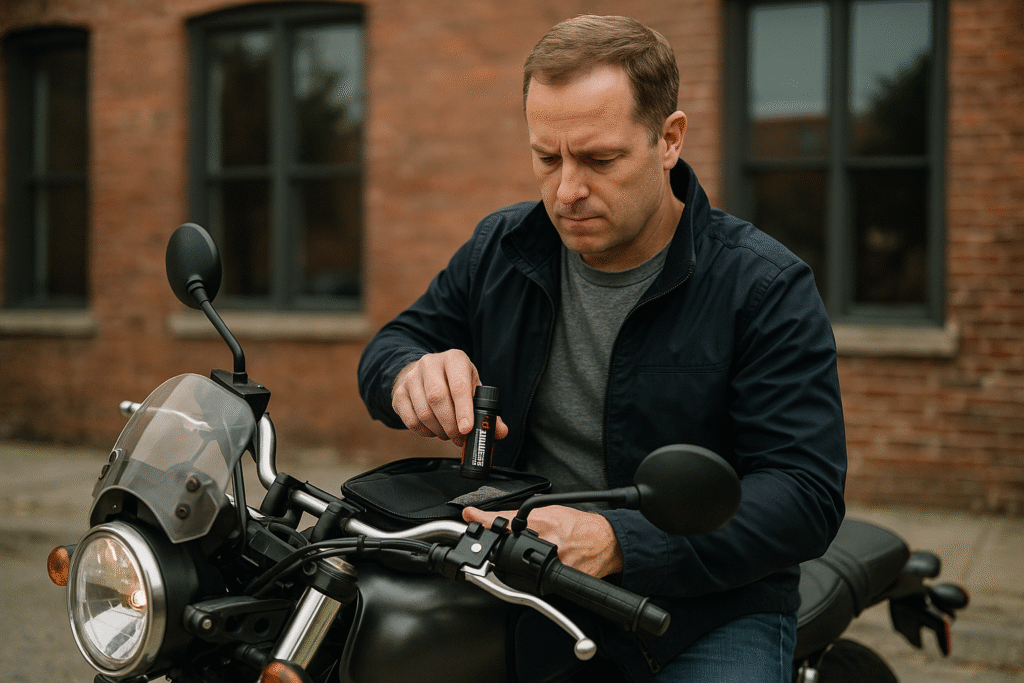
Car Everyday Carry: Official Government Guidance
Okay, we’ve covered the personal approach. But what do the experts say? It’s worth looking at the official guidance from agencies like Ready.gov and FEMA. Their recommendations aren’t just guesses; they’re based on decades of data from real emergencies.
Ready.gov, part of FEMA, suggests keeping these in your vehicle: jumper cables, flares, a flashlight, a first aid kit, a phone charger, a blanket, snacks, water, and a map. In cold areas, they add an ice scraper and sand or cat litter for traction.
The National Safety Council has a very extensive emergency car kit list including blankets, compass, poncho, snow brush and more. The site also has topics on natural disasters like tornadoes and keeping an emergency kit for your home.
The American Red Cross boils it down to a simple checklist: a flashlight, phone charger, jumper cables, tire repair tools, and seasonal gear.
These agencies also recommend having an emergency kit at home with at least three days of food and water, a radio, a whistle, masks, and important documents. They even provide free family emergency plan templates to help you figure out how to contact each other in a crisis.
Their best advice? Revisit your kits every six months. Replace expired food or batteries, and adjust for seasonal risks.
Official Resources You Can Trust If you want to dig deeper or grab printable checklists, here are some great resources:
- Ready.gov Car Safety
- NHTSA Summer & Road Trip Tips
- American Red Cross Emergency Preparedness Checklist (PDF)
- Ready.gov Emergency Supply List (PDF)
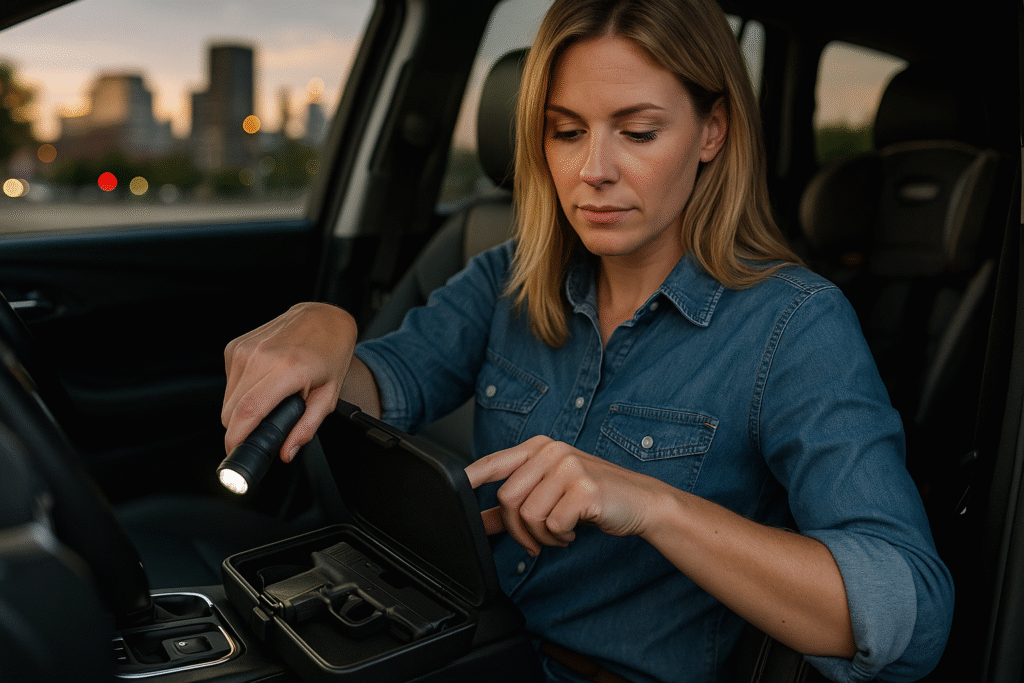
Putting It All Together
By now, you’ve seen two solid ways to prep your vehicle: the practical, personal loadout and the official safety recommendations. The best Car EDC setup combines both.
Think of your kit in layers. Keep quick-grab essentials like a flashlight and first aid kit up front. Store heavier gear like blankets and jumper cables in a tote in the trunk. This layered approach lets you adapt. Running errands close to home? You still have the basics. Heading out on a road trip? Toss in the full kit.
Use the official checklists as your foundation, then customize it for your world. Driving with kids? Add snacks and a toy. Commuting through sketchy areas? Maybe a tactical flashlight goes in the console.
And don’t forget to make maintenance a habit. The biggest mistake is building a kit and then forgetting about it. Check your gear at least twice a year. That small habit ensures your kit will be ready when you actually need it.
Most people don’t think about their car until something goes wrong, and by then, it’s too late. Building a Car EDC kit isn’t about being paranoid; it’s about being realistic. A good kit can turn a potential nightmare into a simple inconvenience.
So take a few minutes this week. Use these lists, pull from the official resources, and build a kit for your life. That’s all it takes to go from hoping for the best to knowing you’re ready for what comes next.
Affiliate Disclosure: Everyday Gun Owner is a participant in the Amazon Services LLC Associates Program, an affiliate advertising program designed to provide a means for sites to earn advertising fees by advertising and linking to Amazon.com. As an Amazon Associate, we earn from qualifying purchases.
This means if you click on a link and make a purchase, we may earn a small commission at no extra cost to you. We only recommend products we use and trust.
